Formation of Mo5Si3/Mo3Si–MgAl2O4 Composites via Self-Propagating High-Temperature Synthesis
Abstract
:1. Introduction
2. Materials and Methods
3. Results and Discussion
3.1. Combustion Wave Kinetics and Activation Energy
3.2. Microstructure and Composition of SHS-Derived Composites
4. Conclusions
Author Contributions
Funding
Acknowledgments
Conflicts of Interest
References
- Petrovic, J.J. Toughening strategies for MoSi2-based high temperature structure silicides. Intermetallics 2000, 8, 1175–1182. [Google Scholar] [CrossRef]
- Zhang, L.; Tong, Z.; He, R.; Xie, C.; Bai, X.; Yang, Y.; Fang, D. Key issues of MoSi2-UHTC ceramics for ultra high temperature heating element applications: Mechanical, electrical, oxidation and thermal shock behaviors. J. Alloys Compd. 2019, 780, 156–163. [Google Scholar] [CrossRef]
- Azim, M.A.; Christ, H.-J.; Gorr, B.; Kowald, T.; Lenchuk, O.; Albe, K.; Heilmaier, M. Effect of Ti addition on the thermal expansion anisotropy of Mo5Si3. Acta Mater. 2017, 132, 25–34. [Google Scholar] [CrossRef]
- Pan, Y.; Wang, P.; Zhang, C.M. Structure, mechanical, electronic and thermodynamic properties of Mo5Si3 from first-principles calculations. Ceram. Int. 2018, 44, 12357–12362. [Google Scholar] [CrossRef]
- Lemberg, J.A.; Ritchie, R.O. Mo–Si–B alloys for ultrahigh-temperature structural applications. Adv. Mater. 2012, 24, 3445–3480. [Google Scholar] [CrossRef] [PubMed]
- Abbasi, A.R.; Shamanian, M. Synthesis of α-Mo–Mo5SiB2–Mo3Si nanocomposite powders by two-step mechanical alloying and subsequent heat treatment. J. Alloys Compd. 2011, 509, 8097–8104. [Google Scholar] [CrossRef]
- Chen, H.; Ma, Q.; Shao, X.; Ma, J.; Wang, C.; Huang, B. Microstructure, mechanical properties and oxidation resistance of Mo5Si3–Al2O3 composites. Mater. Sci. Eng. A 2014, 592, 12–18. [Google Scholar] [CrossRef]
- Wang, L.; Fu, Q.; Zhao, F. Improving oxidation resistance of MoSi2 coating by reinforced with Al2O3 whiskers. Intermetallics 2018, 94, 106–113. [Google Scholar] [CrossRef]
- Chen, H.; Shao, X.; Wang, C.Z.; Pu, X.P.; Zhao, X.C.; Huang, B.X.; Ma, J. Mechanical and wear properties of Mo5Si3–Mo3Si–Al2O3 composites. Intermetallics 2017, 85, 15–25. [Google Scholar] [CrossRef]
- Ganesh, I. A review on magnesium aluminate (MgAl2O4) spinel: Synthesis, processing and applications. Int. Mater. Rev. 2013, 58, 63–112. [Google Scholar] [CrossRef]
- Ma, Y.; Liu, X. Kinetics and thermodynamics of Mg-Al disorder in MgAl2O4-spinel: A review. Molecules 2019, 24, 1704. [Google Scholar] [CrossRef] [PubMed] [Green Version]
- Ganesh, I.; Srinivas, B.; Johnson, R.; Saha, B.P.; Mahajan, Y.R. Microwave assisted solid state reaction synthesis of MgAl2O4 spinel powders. J. Eur. Ceram. Soc. 2004, 24, 201–207. [Google Scholar] [CrossRef]
- Wen, Y.; Liu, X.; Chen, X.; Jia, Q.; Yu, R.; Ma, T. Effect of heat treatment conditions on the growth of MgAl2O4 nanoparticles obtained by sol-gel method. Ceram. Int. 2017, 43, 15246–15253. [Google Scholar] [CrossRef]
- Padmaraj, O.; Venkateswarlu, M.; Satyanarayana, N. Structural, electrical and dielectric properties of spinel type MgAl2O4 nanocrystalline ceramic particles synthesized by the gel-combustion method. Ceram. Int. 2015, 41, 3178–3185. [Google Scholar] [CrossRef]
- Merzhanov, A.G. Combustion processes that synthesize materials. J. Mater. Process. Technol. 1996, 56, 222–241. [Google Scholar] [CrossRef]
- Levashov, E.A.; Mukasyan, A.S.; Rogachev, A.S.; Shtansky, D.V. Self-propagating high-temperature synthesis of advanced materials and coatings. Int. Mater. Rev. 2017, 62, 203–239. [Google Scholar] [CrossRef]
- Liu, G.; Chen, K.; Li, J. Combustion synthesis: An effective tool for preparing inorganic materials. Scr. Mater. 2018, 157, 167–173. [Google Scholar] [CrossRef]
- Sharifitabar, M.; Vahdati Khaki, J.; Haddad Sabzevar, M. Formation mechanism of TiC–Al2O3–Fe3Al composites during self-propagating high-temperature synthesis of TiO2–Al–C–Fe system. Ceram. Int. 2016, 42, 12361–12370. [Google Scholar] [CrossRef]
- Ghorbantabar Omran, J.; Sharifitabar, M.; Shafiee Afarani, M. On the self-propagating high-temperature synthesis of tungsten boride containing composite powders from WO3–B2O3–Mg system. Ceram. Int. 2018, 44, 14355–14362. [Google Scholar] [CrossRef]
- Yeh, C.-L.; Ke, C.-Y. Combustion synthesis of FeAl-based composites from thermitic and intermetallic Reactions. Crystals 2019, 9, 127. [Google Scholar] [CrossRef] [Green Version]
- Zaki, Z.I.; Mostafa, N.Y.; Rashad, M.M. High pressure synthesis of magnesium aluminate composites with MoSi2 and Mo5Si3 in a self-sustaining manner. Ceram. Int. 2012, 38, 5231–5237. [Google Scholar] [CrossRef]
- Horvitz, D.; Gotman, I. Pressure-assisted SHS synthesis of MgAl2O4–TiAl in situ composites with interpenetrating networks. Acta Mater. 2002, 50, 1961–1971. [Google Scholar] [CrossRef]
- Omran, J.G.; Afarani, M.S.; Sharifitabar, M. Fast synthesis of MgAl2O4–W and MgAl2O4–W–W2B composite powders by self-propagating high-temperature synthesis reactions. Ceram. Int. 2018, 44, 6508–6513. [Google Scholar] [CrossRef]
- Yeh, C.L.; Chen, W.L. A combustion route to synthesize Mo5SiB2–Al2O3 composites. Vacuum 2019, 163, 288–291. [Google Scholar] [CrossRef]
- Binnewies, M.; Milke, E. Thermochemical Data of Elements and Compounds; Wiley-VCH Verlag GmbH: Weinheim, Germany, 2002; pp. 692–693. [Google Scholar]
- Liang, Y.H.; Wang, H.Y.; Yang, Y.F.; Zhao, R.Y.; Jiang, Q.C. Effect of Cu content on the reaction behaviors of self-propagating high-temperature synthesis in Cu-Ti-B4C system. J. Alloys Compd. 2008, 462, 113–118. [Google Scholar] [CrossRef]
- Yeh, C.L.; Chen, Y.L. An experimental study on self-propagating high-temperature synthesis in the Ta-B4C system. J. Alloys Compd. 2009, 478, 163–167. [Google Scholar] [CrossRef]
- Bradley, D.; Matthews, K.J. Measurement of high gas temperatures with fine wire thermocouples. J. Mech. Eng. Sci. 1968, 10, 299–305. [Google Scholar] [CrossRef]
- Holman, J.P. The Measurement of Temperature. In Experimental Methods for Engineers, 7th ed.; McGraw-Hill: New York, NY, USA, 2001; pp. 390–399. [Google Scholar]
- Evans, A.G.; Charles, E.A. Fracture toughness determinations by indentation. J. Am. Ceram. Soc. 1976, 59, 371–372. [Google Scholar] [CrossRef]
- Rios, C.T.; Coelho, A.A.; Batista, W.W.; Gonçalves, M.C.; Caram, R. ISE and fracture toughness evaluation by Vickers hardness testing of an Al3Nb-Nb2Al-AlNbNi in situ composite. J. Alloys Compd. 2009, 472, 65–70. [Google Scholar] [CrossRef]
- Merzhanov, A.G. Solid flames: Discoveries, concepts, and horizons of cognition. Combust. Sci. Technol. 1994, 98, 307–336. [Google Scholar] [CrossRef]
- Varma, A.; Rogachev, A.S.; Mukasyan, A.S.; Hwang, S. Combustion synthesis of advanced materials: Principals and applications. Adv. Chem. Eng. 1998, 24, 79–225. [Google Scholar]
- Yeh, C.L.; Wang, H.J. A comparative study on combustion synthesis of Ta-B compounds. Ceram. Int. 2011, 37, 1569–1573. [Google Scholar] [CrossRef]
- Williams, R.A.; Schoenitz, M.; Ermoline, A.; Dreizin, E.L. Low-temperature exothermic reactions in fully-dense Al/MoO3 nanocomposite powders. Thermochim. Acta 2014, 594, 1–10. [Google Scholar] [CrossRef]
- Massalski, T.B.; Okamoto, H.; Subramanian, P.R.; Kacprzak, L. Binary Alloy. Phase Diagrams; ASM International: Materials Park, OH, USA, 1987. [Google Scholar]
- Rosales, I.; Schneibel, J.H. Stoichiometry and mechanical properties of Mo3Si. Intermetallics 2000, 8, 885–889. [Google Scholar] [CrossRef]
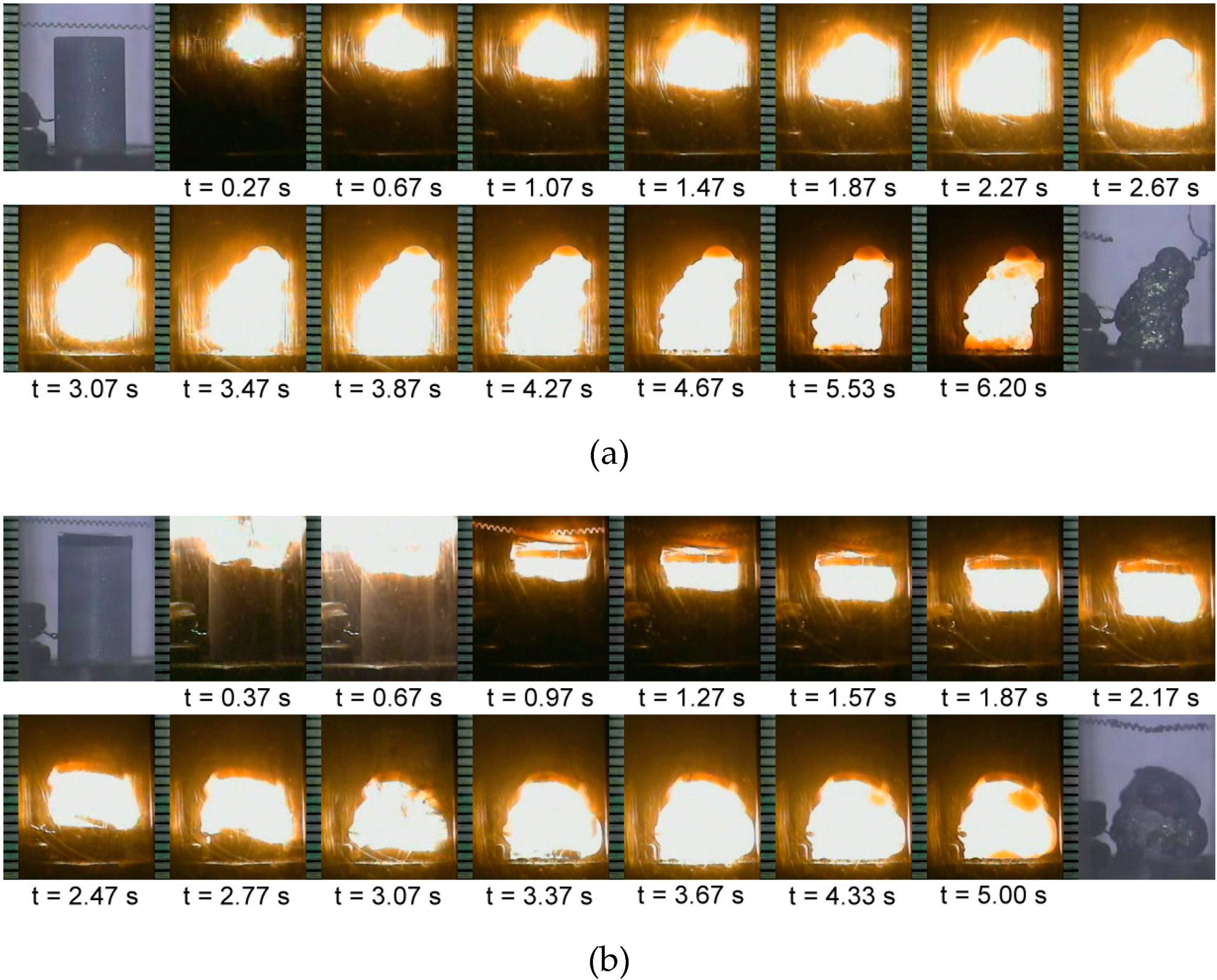
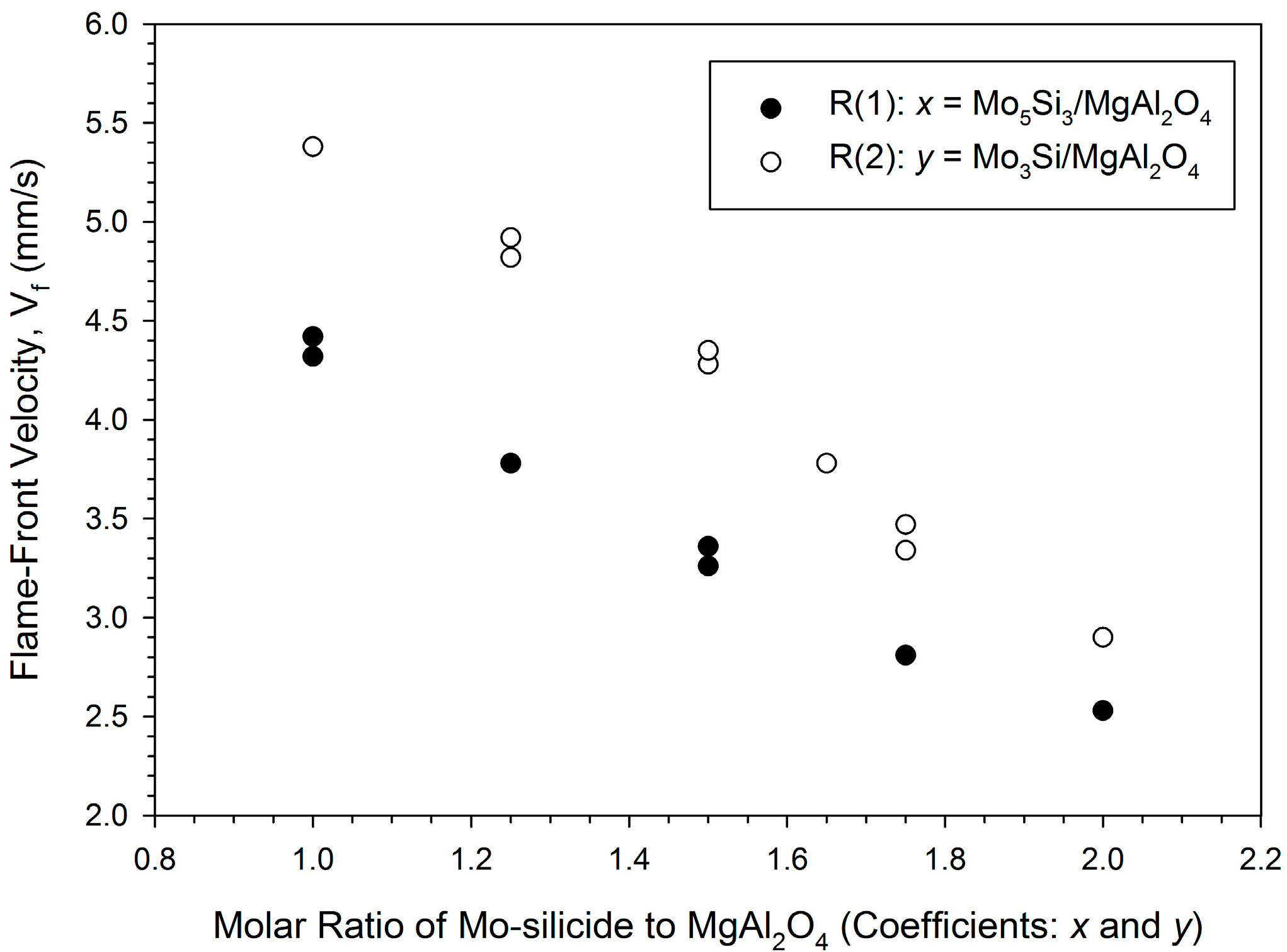
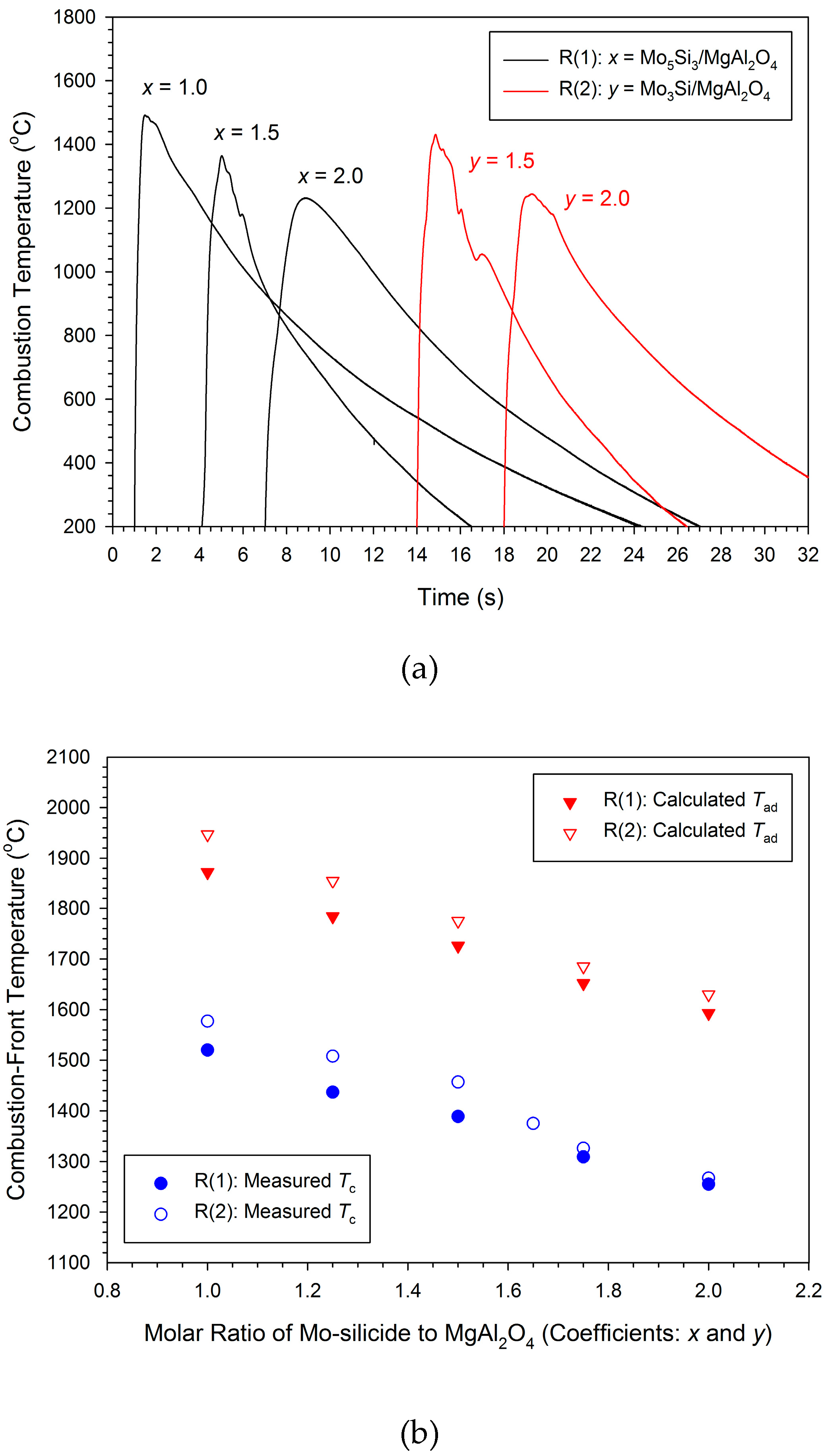
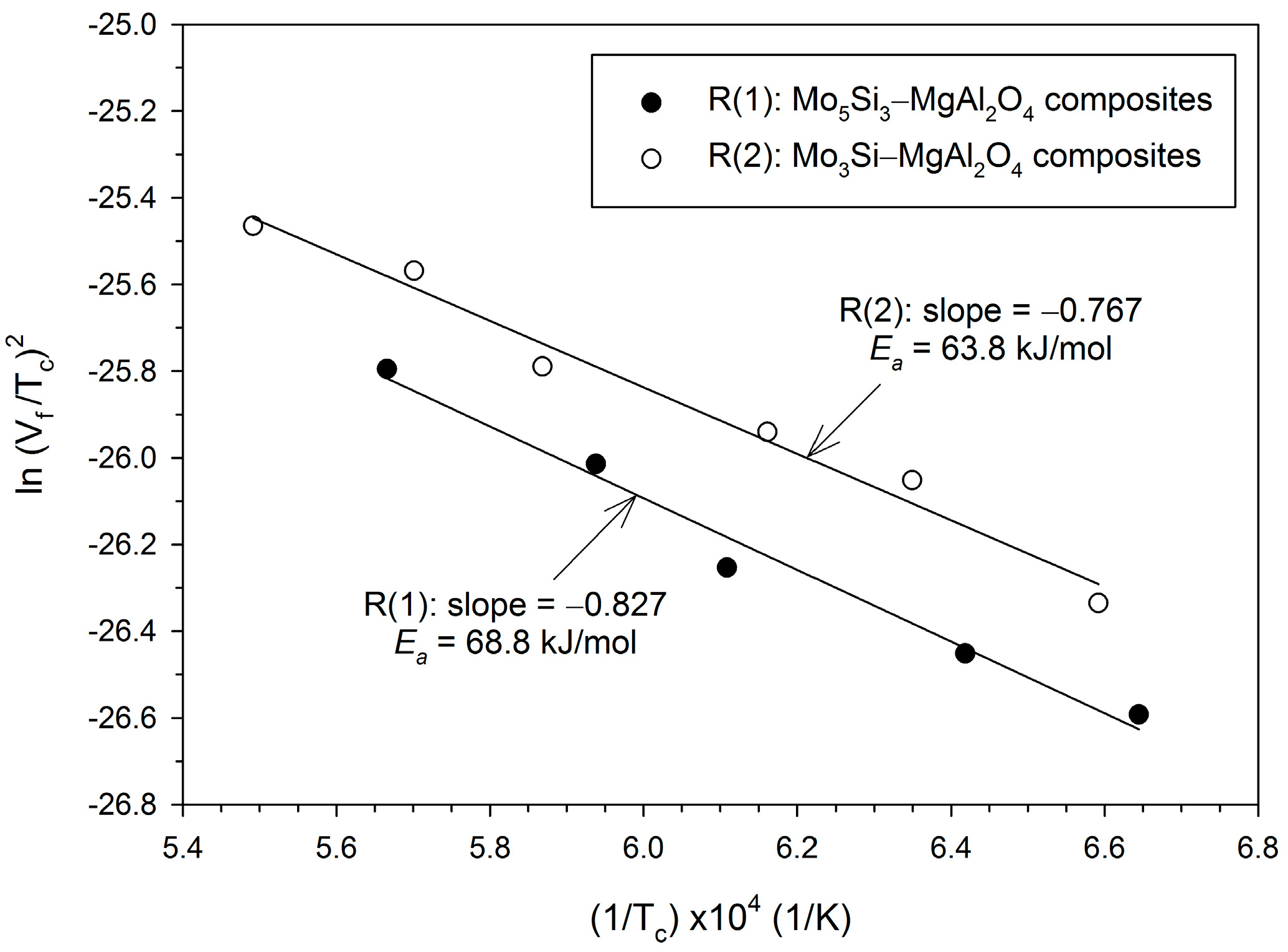
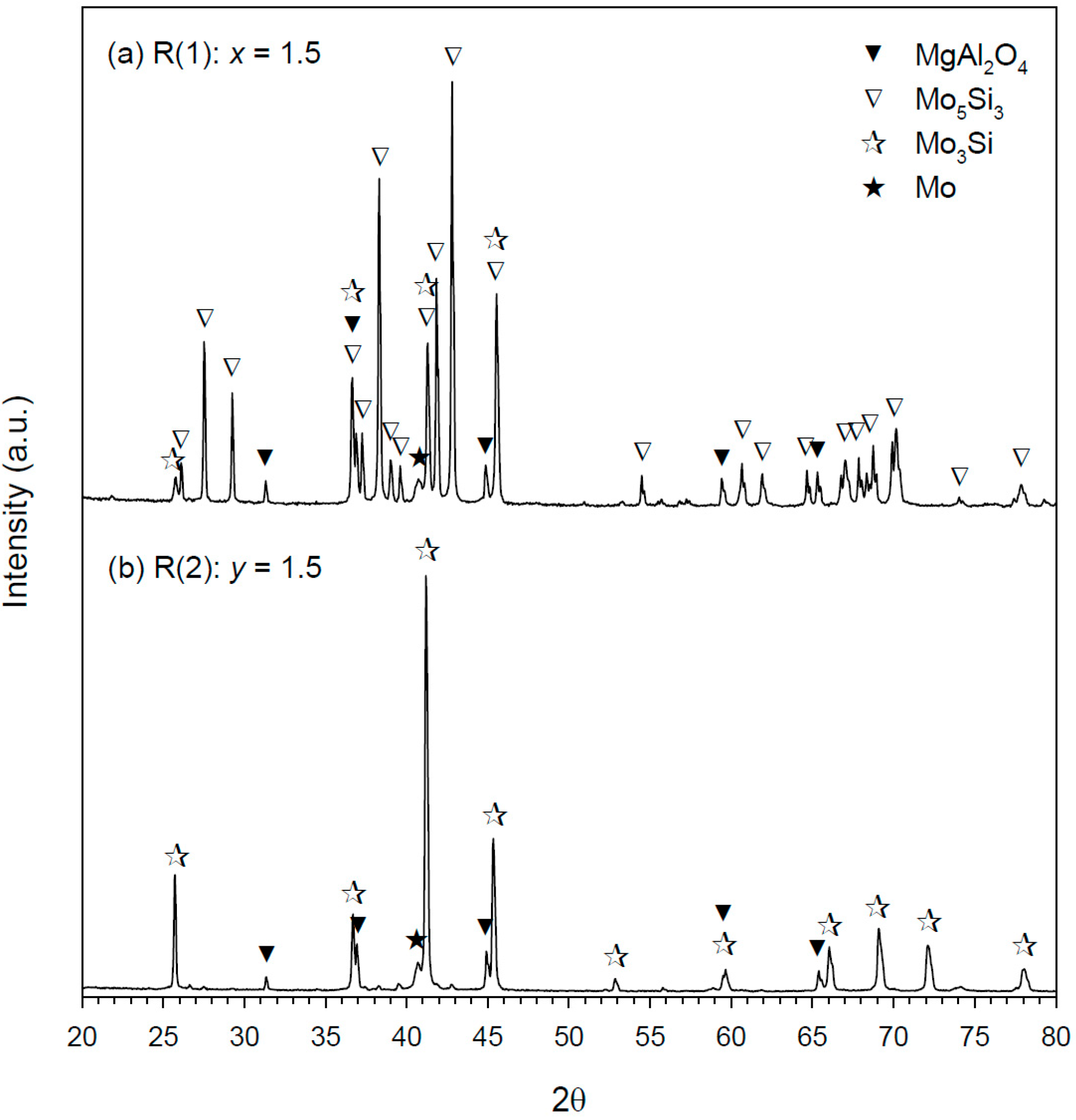

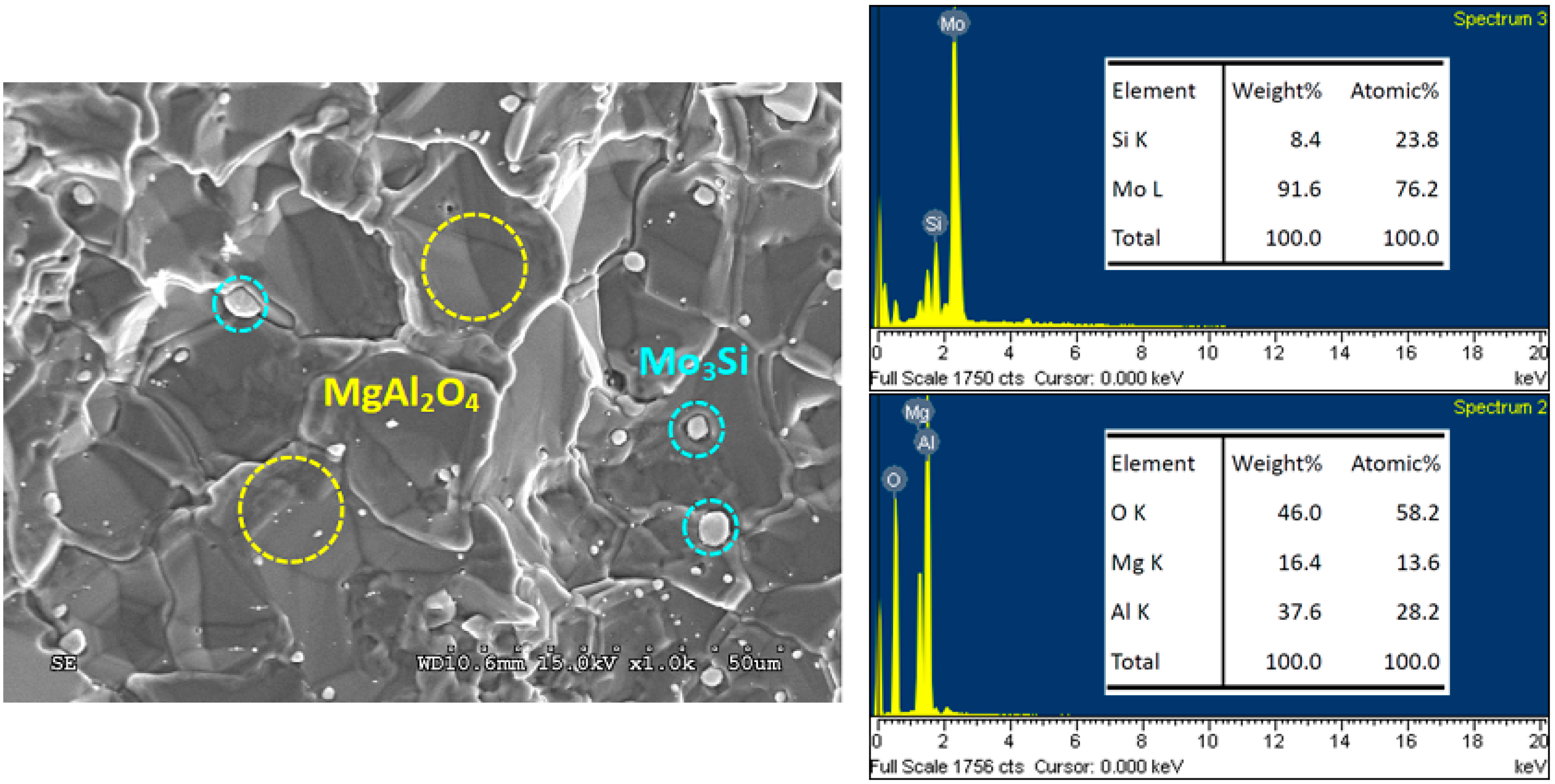
© 2019 by the authors. Licensee MDPI, Basel, Switzerland. This article is an open access article distributed under the terms and conditions of the Creative Commons Attribution (CC BY) license (http://creativecommons.org/licenses/by/4.0/).
Share and Cite
Yeh, C.-L.; Chen, Y.-C. Formation of Mo5Si3/Mo3Si–MgAl2O4 Composites via Self-Propagating High-Temperature Synthesis. Molecules 2020, 25, 83. https://doi.org/10.3390/molecules25010083
Yeh C-L, Chen Y-C. Formation of Mo5Si3/Mo3Si–MgAl2O4 Composites via Self-Propagating High-Temperature Synthesis. Molecules. 2020; 25(1):83. https://doi.org/10.3390/molecules25010083
Chicago/Turabian StyleYeh, Chun-Liang, and Yin-Chien Chen. 2020. "Formation of Mo5Si3/Mo3Si–MgAl2O4 Composites via Self-Propagating High-Temperature Synthesis" Molecules 25, no. 1: 83. https://doi.org/10.3390/molecules25010083




